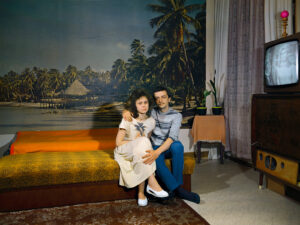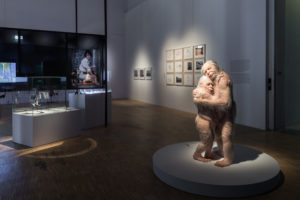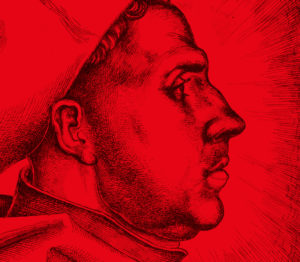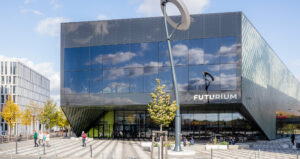
Museum of Futures
Futurium – that’s the name of Berlin’s new museum of technology and society. It’s a place of information, for reflecting on creative ways to solve current problems and co-imagining alternative futures.
Many people feel insecure and uneasy about the present. That was the case even before the COVID-19 pandemic, and the disease has only made it worse: an ideal breeding ground for all manner of visions of the future. As usual, some of those visions extol the virtues of a technological utopia. We just need to have the right tools; then we can control everything. Others paint a dark picture of grim dystopias. Frightening scenarios of the disintegration of our society, or the failure of critical functional connections such as power supply, the internet or supply chains, have been doing the rounds for years. To some degree, these scenarios are actually reality here and there. And the climate apocalypse is still looming. From this perspective, it seems there are no alternatives to the bleak visions and, in particular, no options for action.
Or does it? It’s precisely these issues that Berlin’s newest museum, with its pseudo-Latin name ‘Futurium’, aims to address. Futurium was opened in September 2019. In a nutshell, it’s a prestige project for scientific communication established at the highest echelons of politics. The project is headed by Germany’s Federal Ministry of Education and Research. Major research establishments such as the Max Planck Institute and the Helmholtz Association are also involved. In addition to notable names in climate research, technological impact assessment and ethics, the mix even includes art and design. Alongside Deutschlandradio, the Bundeskunsthalle was one of the initiators of the idea. It comes as no surprise, then, that contributors from the industrial sphere, from BASF to Siemens and Infineon, have also been welcomed.
The €58 million building is within walking distance of Berlin’s Hauptbahnhof, with a view over the capital’s government district. The cool glass and steel structure is a perfect fit for the newly created quarter on the banks of the Spree, which is now being systematically crammed with ‘Neuberliner’ test-tube architecture. Isn’t this what yesterday’s vision of the future of architecture looked like? Anyway, as the website reveals, it’s a low-energy building.
As soon as we leave the reception area (with human staff) heading towards the exhibition, we’re accosted by Pepper the talking robot. ‘Hello, little person!’ he greets us. It would be hard to come up with anything that more perfectly expresses the humiliation of human by machine. But the supercilious little Pepper doesn’t (yet) notice our slightly raised eyebrows. We obediently comply with Pepper’s request to put on the proffered wristband with interactive badge. The wristband allows you to give your own opinion at various points in the exhibition and gain access to further information.
That’s a bit creepy. Are we going to be part of an experiment ourselves? But allegedly, the data will not be analysed (yet). We turn our attention to the exhibition. It starts with a timeline depicting in visual form milestones in technological and societal development since the Industrial Revolution, such as the advent of electricity, the invention of plastic and a skyrocketing population. This is informative and, like the entire museum, very attractively designed and laid out, albeit a little too much text to be starting with. As a result, we are easily distracted by the eye-catching web of rubber cords on the wall beside it. The web symbolises the ‘conflicting priorities of the future’ and the forces pulling at them. These priorities are summarised by keywords such as ‘Hopes’, ‘People’, ‘World population’, ‘Cultural diversity’, ‘Science’, ‘Protest’, ‘Economy’. So far, so trivial: shaping the future is a complex and elastic issue.
Happily, it’s quickly becoming more tangible. We discover, from an overview diagram that’s also designed for the visually impaired – the Futurium strives to be a flagship candidate in accessibility – that the exhibition is organised into three ‘thinking spaces’. These separate spaces focus on nature, technology and human beings respectively. We dive in with five topics relating to technology: Genes and Medicine, Robots, Digital World, Energy, New Materials.
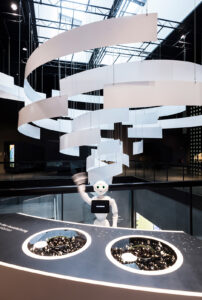
‘Pepper’ greets visitors to the exhibition.
Futurium, David von Becker
Our scepticism increasingly gives way to wonder. In a very clear, visually descriptive way, we are told about the latest developments in technology, with a well-balanced mix of informative and accessible texts, images, interactive elements and exhibits (such as the ground-breaking talking ‘therapy seal’ and its further enhancements). We come face to face with clever prostheses, dental repair bots and cool techno materials, as well as the possibilities of personalised medicine.
But can’t a high-tech trade show do all this better? No; it’s precisely here that Futurium goes the crucial extra mile: in a structured and focused way, visitors are drawn into a dialogue about the pros and cons of dominant technological trends. This is how an expert on medical ethics would talk. Is everything that’s doable also desirable – and at what price? Using the badge you got from Pepper, you’re able to give your own individual response to the questions posed. Such as whether you can imagine receiving nursing care from a robot. Would you bet that, in the light of our recent experience with COVID-19, the answer will be different from before the pandemic? Robots would be very unlikely to infect themselves and others, and could be used for routine activities. Actual humans are perhaps better suited for the challenges of providing intensive care.
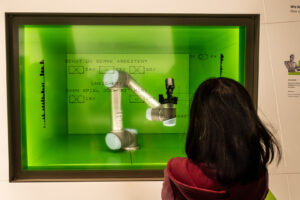
In the Technology thinking space.
Futurium, Ali Ghandtschi
Even more persuasive is the ‘Society’ section. Here, the narcissistic techno-speculation is challenged. The spotlight is on the implications of technologies such as 3D printing for future manufacturing and supply chains, but also for the working environment(s) of the future. In addition, quite tangible areas of action and performance models are presented, relating, for example, to consumption, new models for co-determination and planning, and sharing initiatives. For now, the primary response to the coronavirus pandemic is discussion events looking at issues such as the consequences of the pandemic for the climate debate.
The third section, on the future of nature, is the most dazzling. From ‘greened’ architecture and buildings constructed from biomaterials, to climate and nutrition, every current trend is covered. Of course, the mealworms and grasshoppers that we’re supposed to be eating more of in the future, and that have already started turning up on the speciality shelf at your local food store, shouldn’t be left out. And it’s even more fun with the Japanese designer cutlery invented specially for tucking into these critters. The section on microorganisms as little helpers will make the hearts of homemakers skip a beat. It’s now clear to us all how seriously these baddies must be taken as a threat – there’s a need for adjustments to be made in how we treat them.
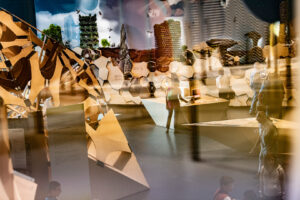
In the Nature thinking space.
Futurium, Jan Windszus
The rich array of exhibits on offer tempts you to linger, but we don’t have time. The roof-top Skywalk, inviting you to take a break and admire the breath-taking view, is not to be missed. We hand in our Pepper wristbands. The computer spits out the analysis of our visitor voting (according to which we have an affinity for people rather than technology) and a code for the website. It’s a shame we don’t even have time for a bite in the Museum’s own restaurant. At least that saves our wallets – the ‘toasted insects’ topping alone will set you back a hefty €3.50. If insects as the future ‘food for the masses’ come down a bit in price, we can revisit the subject.
At home, we consult the website and key in our code. We like the blog better than the somewhat scant in-depth material. While browsing, we also discover that Futurium is proving a hit. In the few months since it opened, 340,000 visitors have already passed through its doors – well in excess of the expected 200,000 per year. Now, after the break for coronavirus, it certainly helps that entry is still free, but also that Futurium has taken a refreshingly new approach to the concept of the museum, reinventing it as a platform that not only delivers information and learning, but also presents options for action and offers hope for the future – something that’s more in demand now than ever.
Futurium, Berlin
Admission free.

